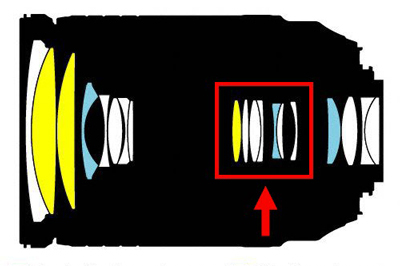Continuous Close Focus Zoom Reduces Focal Length
One of the optical issues photographers often have to deal with has to do with focus breathing. It commonly occurs on many modern lenses, making it difficult to understand their true optical properties. In this article, we will take a closer look at focus breathing, how it affects images and what you can do to minimize its impact.
What is Focus Breathing?
Focus breathing is a term that describes the change in focal length that occurs as a result of adjusting the focusing distance of a lens. It is a common issue that occurs on many photographic lenses. As focus is adjusted from close focus to infinity, focus breathing causes noticeable changes in both angle of view and magnification.
These changes are often clearly visible to the photographer during the process of focusing, with different lenses exhibiting varying levels of focal length changes. Focus breathing issues can occur on both prime and zoom lenses.

NIKON D810 + 70-200mm f/2.8 @ 130mm, ISO 100, 1/800, f/2.8
There are typically two scenarios when photographers notice focus breathing. The first is fairly common, because it has to do with the magnification or "reach" of a lens at close distances. Some lenses, such as the Nikon 70-200mm f/2.8G VR II, exhibit so much of it, that at 200mm and focused on a close subject, it makes the lens look more like a 120mm lens. This catches many photographers by surprise, because they do not expect to see such odd behavior – they expect their lens to magnify the subject as a "real" 200mm lens does at any distance.


Take a look at the above two images. The "before" image on the left part of the slider shows the Nikon 50mm f/1.4G at its closest focusing distance (focused on BB-8 on the bottom right), while the "after" image shows the same lens focused at the white figure in the back (First Order Stormtrooper). Pay attention to how much the framing changes between the two shots – the "after" image looks zoomed out, as if it was shot with a shorter focal length lens. This is the effect of focus breathing on the 50mm f/1.4G lens. The Nikon 70-200mm f/2.8G VR II lens mentioned above shows even more significant levels at 200mm.
The second scenario involves focus stacking when shooting macro, landscape or architecture photography. Photographers notice visible changes in angle of view at close vs farther focus distances (especially infinity), which can make it difficult to merge all images into a single stack successfully during post-processing.

NIKON Z 7 + NIKKOR Z 35mm f/1.8 S @ 35mm, ISO 64, 6 sec, f/11.0
Unfortunately, aside from some high-end (and very expensive) cine lenses, most modern lenses exhibit some form of focus breathing. Why does this happen and is it a big problem?
Why Lenses "Breathe"
Most modern lenses today feature "internal focus" design, which basically moves a group of internal lens elements instead of the whole lens barrel when focus is adjusted. This makes it convenient to use filters on lenses, because the front element does not rotate while focusing. Another benefit of internal focus, is that it does not affect the overall size of the lens – it stays the same at any focus distance. Lastly, it is faster to move a small and lightweight group of lenses instead of the lens barrel when focusing, which increases autofocus speed and makes the autofocus motor less noisy. Because of these and other advantages, lens manufacturers have been mostly releasing lenses with internal focus designs.

Unfortunately, such lenses also come with one big disadvantage – they often exhibit focus breathing. As the group of internal focus lens elements are moved during focusing, others stay in place, which can affect the optical characteristics of the lens, including focal length. Depending on the size of the internal focus group and the overall optical design, the change in focal length can vary, from small to large.
So why don't manufacturers reflect this in their lens specifications? Why is a 70-200mm f/2.8 lens that has a similar angle of view as a 120mm lens at 200mm still referred to as a 70-200mm lens? Because it only happens at close focusing distances. Since the focal length of a lens is measured at infinity, a 70-200mm lens is going to have proper focal lengths of 70 and 200mm at both ends of the zoom range when focused at infinity. Manufacturers often do provide information in their specifications to be able to identify lenses with focus breathing properties, and we will go through that further down in the article.
Note:
It is important to note that focus breathing in lenses always causes a decrease in focal length, not an increase.
Lens designers sometimes take this into account by specifically designing lenses that exhibit minimal amount of focus breathing. After many complaints from photographers, Nikon's engineers updated the aforementioned 70-200mm f/2.8G VR II lens with a completely new optical formula that minimized focus breathing. The result of this effort was the Nikon AF-S NIKKOR 70-200mm f/2.8E FL ED VR, which showed a drastic improvement in focus breathing compared to its predecessor, as we detailed in our review.

NIKON D850 + 70-200mm f/2.8 @ 95mm, ISO 64, 0.6 sec, f/5.6
With the release of the new Nikon S-series lenses for the Z mount, Nikon's engineers are now specifically designing each lens to exhibit a minimal amount of focus breathing as part of their lens design.


Compare these two images from the Nikon Z 50mm f/1.8 S to the ones from the Nikon 50mm f/1.4G provided earlier. You will notice that the new Z mount 50mm f/1.8 S shows very little focus breathing compared to its f/1.4G counterpart.
Other manufacturers are following suit because they understand how frustrating it can be for photographers to encounter such lenses.
How to Find Out If a Lens Has Issues
The easiest way to find out of a lens has focus breathing issues is to take a look at its specifications, specifically at its maximum magnification, which is also known as "maximum reproduction ratio" or just "reproduction ratio". Simply put, maximum magnification is the ratio of the size of the image on the image sensor relative to the actual size of the subject. This information can be easily used to determine how much focus breathing a lens exhibits when compared to other similar lenses.
Let's take a look at the last three 70-200mm f/2.8 lenses produced by Nikon and compare them side-by-side, along with the 70-200mm f/4G VR:
| Nikon Lens | Maximum Magnification |
|---|---|
| Nikon AF-S NIKKOR 70-200mm f/2.8G IF-ED VR | 0.25x |
| Nikon AF-S NIKKOR 70-200mm f/2.8G ED VR II | 0.12x |
| Nikon AF-S NIKKOR 70-200mm f/2.8E FL ED VR | 0.21x |
| Nikon AF-S NIKKOR 70-200mm f/4G ED VR | 0.274x |
As you can see, the Nikon 70-200mm f/2.8G ED VR II has the lowest maximum magnification / reproduction ratio of 0.12x in the group, so it is no surprise that it is the worst offender in terms of focus breathing. The first 70-200mm had a respectable maximum magnification of 0.25x, which is why photographers quickly noticed how bad focus breathing on the newer VR II version was when compared to its predecessor. Nikon's latest 70-200mm f/2.8E FL VR is much better at 0.21x, but the best performer here is clearly the Nikon 70-200mm f/4G VR, which has a maximum magnification of 0.274x – the best in the group.
So if I were looking for a lens that shows the least amount of focus breathing among Nikon's 70-200mm lenses, I would be picking the f/4 version. It is cheaper and lighter than the rest, and it would make an excellent candidate for focus stacking.
However, that is not why we buy 70-200mm f/2.8 lenses, is it? Portrait photographers desire 70-200mm f/2.8 lenses because of their optical qualities and they rarely ever pay attention to focus breathing, as explained further down below.
Now if you don't have lens specifications in front of you, you can also do a quick test on your lens to see if it suffers from focus breathing. The test is quite simple – set your camera on a tripod, then rotate the focus ring from close focus to infinity and see if the image seems to "zoom out" as you focus. If it does (which it most likely will), your lens has focus breathing. If you see big changes in angle of view as you focus, it means that your lens has a lot of focus breathing.
How to Eliminate Focus Breathing
Since we know that focus breathing is only a major problem at close focusing distances and never at infinity, the solution would be to force the lens to focus at infinity, even when focusing on close subjects. The only way to be able to achieve that is to use extension tubes.

By using one or more extension tubes, you would be moving the lens further away from the camera (since it is just a hollow spacer) and allowing it to focus at infinity at much closer distances, which in turn, would reduce or potentially even eliminate focus breathing.
While on one hand using extension tubes sounds like a great idea, they unfortunately bring a slew of problems with them. First of all, you would lose autofocus capabilities of the lens with most extension tubes. Second, you would lose some light, which would require using faster shutter speeds / increased ISO. Third, you would lose the ability to focus at subjects far away. And lastly, using an extension tube can deteriorate image quality and add more lens aberrations to your images.
Honestly, considering all the disadvantages listed above, using an extension tube just to be able to get rid of focus breathing is a bad idea for most photographers…
Is Focus Breathing a Big Problem?
Is focus breathing a big problem that every photographer needs to be aware of? Not really. Most photographers aren't even going to notice any differences in angle of view and magnification when using most lenses at close distances. Those who do, are likely comparing different lenses, and just want to find out why they see such differences. So if you are a stills photographer, you should probably ignore the focus breathing issue altogether.
I personally owned the Nikon 70-200mm f/2.8G VR II for many years, despite its heavy focus breathing issues. I shot many events, portraits and weddings with that lens and it paid for itself many times over. That lens had a ton of focus breathing, but I didn't care, as it didn't affect my images.

NIKON D3S + 70-200mm f/2.8 @ 122mm, ISO 800, 1/100, f/2.8
However, if you are a landscape, architecture or macro photographer who wants to be able to focus stack images successfully, especially when shooting subjects from close focus all the way to infinity, then you should pay close attention to the types of lenses you pick. You want to pick lenses that exhibit the least amount of focus breathing so that there are minimal shot-to-shot differences in angle of view when adjusting focus.
Focus breathing is also a pretty big problem for cinematographers, because they do not want to see changes in angle of view when moving focus from one subject to another. Cinematographers specifically pick expensive cine lenses for their work, because they exhibit little to no focus breathing, and have other important optical properties that are critical when shooting videos.
In summary, unless you have these very specific shooting conditions, do not worry about focus breathing, as it probably will not affect your photography in any way.
Source: https://photographylife.com/focus-breathing
Post a Comment for "Continuous Close Focus Zoom Reduces Focal Length"